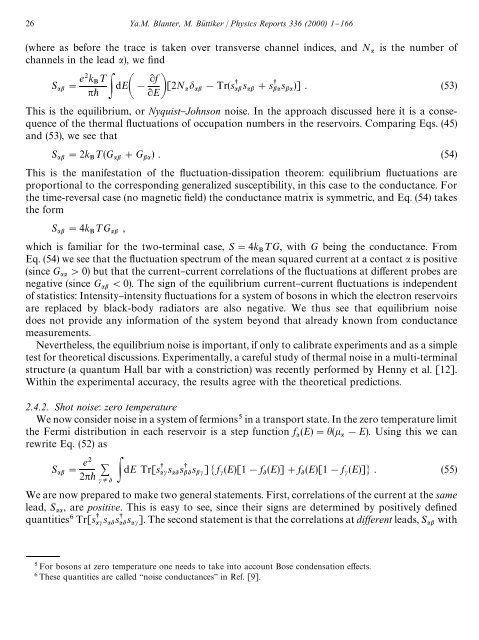shot noise in mesoscopic conductors - Low Temperature Laboratory
shot noise in mesoscopic conductors - Low Temperature Laboratory
shot noise in mesoscopic conductors - Low Temperature Laboratory
You also want an ePaper? Increase the reach of your titles
YUMPU automatically turns print PDFs into web optimized ePapers that Google loves.
26 Ya.M. Blanter, M. Bu( ttiker / Physics Reports 336 (2000) 1}166<br />
(where as before the trace is taken over transverse channel <strong>in</strong>dices, and N is the number of<br />
<br />
channels <strong>in</strong> the lead ), we "nd<br />
S "<br />
ek ¹<br />
dE Rf<br />
! RE [2N !Tr(s s #s s )] . (53)<br />
<br />
This is the equilibrium, or Nyquist}Johnson <strong>noise</strong>. In the approach discussed here it is a consequence<br />
of the thermal #uctuations of occupation numbers <strong>in</strong> the reservoirs. Compar<strong>in</strong>g Eqs. (45)<br />
and (53), we see that<br />
S "2k ¹(G #G ) . (54)<br />
This is the manifestation of the #uctuation-dissipation theorem: equilibrium #uctuations are<br />
proportional to the correspond<strong>in</strong>g generalized susceptibility, <strong>in</strong> this case to the conductance. For<br />
the time-reversal case (no magnetic "eld) the conductance matrix is symmetric, and Eq. (54) takes<br />
the form<br />
S "4k ¹G ,<br />
which is familiar for the two-term<strong>in</strong>al case, S"4k ¹G, with G be<strong>in</strong>g the conductance. From<br />
Eq. (54) we see that the #uctuation spectrum of the mean squared current at a contact is positive<br />
(s<strong>in</strong>ce G '0) but that the current}current correlations of the #uctuations at di!erent probes are<br />
negative (s<strong>in</strong>ce G (0). The sign of the equilibrium current}current #uctuations is <strong>in</strong>dependent<br />
of statistics: Intensity}<strong>in</strong>tensity #uctuations for a system of bosons <strong>in</strong> which the electron reservoirs<br />
are replaced by black-body radiators are also negative. We thus see that equilibrium <strong>noise</strong><br />
does not provide any <strong>in</strong>formation of the system beyond that already known from conductance<br />
measurements.<br />
Nevertheless, the equilibrium <strong>noise</strong> is important, if only to calibrate experiments and as a simple<br />
test for theoretical discussions. Experimentally, a careful study of thermal <strong>noise</strong> <strong>in</strong> a multi-term<strong>in</strong>al<br />
structure (a quantum Hall bar with a constriction) was recently performed by Henny et al. [12].<br />
With<strong>in</strong> the experimental accuracy, the results agree with the theoretical predictions.<br />
2.4.2. Shot <strong>noise</strong>: zero temperature<br />
We now consider <strong>noise</strong> <strong>in</strong> a system of fermions <strong>in</strong> a transport state. In the zero temperature limit<br />
the Fermi distribution <strong>in</strong> each reservoir is a step function f (E)"( !E). Us<strong>in</strong>g this we can<br />
<br />
rewrite Eq. (52) as<br />
S "<br />
e<br />
2 dE Tr[s s s s ] f (E)[1!f (E)]#f (E)[1!f (E)] . (55)<br />
<br />
We are now prepared to make two general statements. First, correlations of the current at the same<br />
lead, S , are positive. This is easy to see, s<strong>in</strong>ce their signs are determ<strong>in</strong>ed by positively de"ned<br />
<br />
quantities Tr[s s s s ]. The second statement is that the correlations at diwerent leads, S with<br />
<br />
For bosons at zero temperature one needs to take <strong>in</strong>to account Bose condensation e!ects.<br />
These quantities are called `<strong>noise</strong> conductancesa <strong>in</strong> Ref. [9].
















